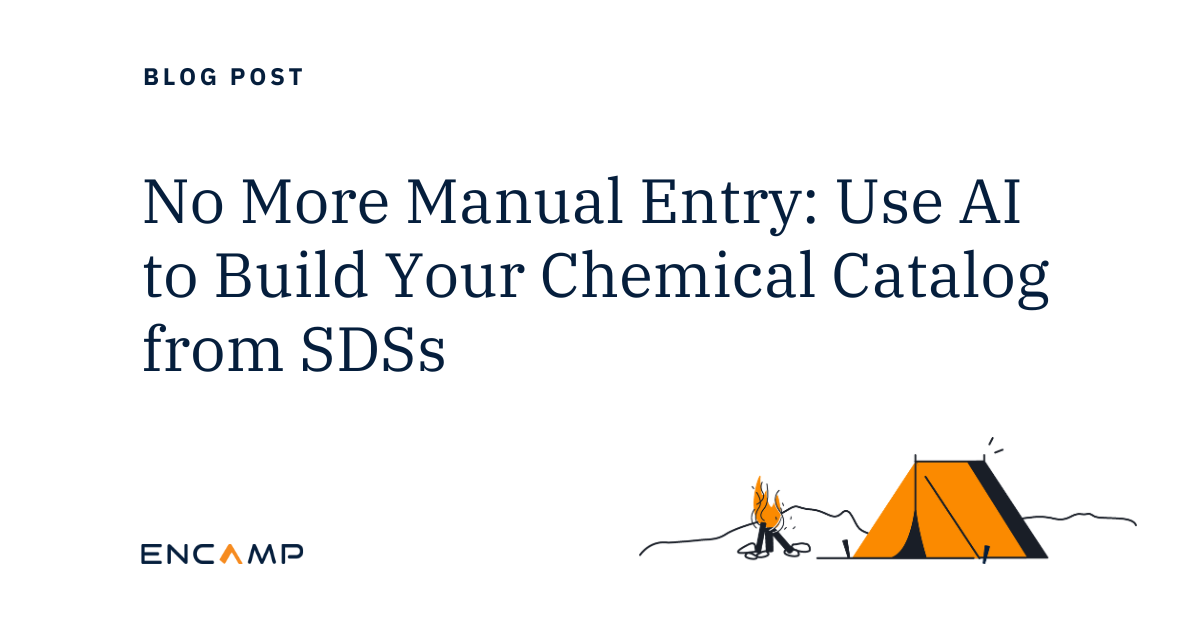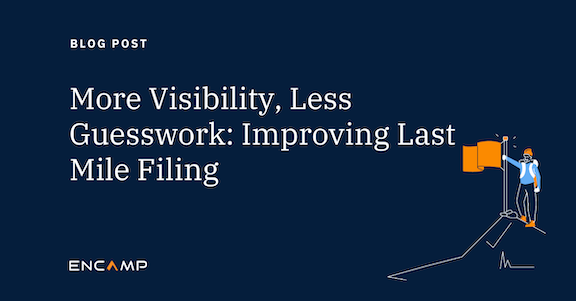Innovation for EHS operations and environmental compliance isn’t just about implementing enhanced technology like the cloud or Software as a Service (SaaS). At this point, it’s about automation and digital agility, process efficiency, and smarter ways of working and solving problems. All of which are marks of digital transformation — or what some corners of the EHS industry call EHS digital transformation.
Especially with the innovative software now available for compliance data management and reporting, the EHS industry is moving more squarely into the crosshairs of EHS digital transformation than it ever has. (Other corners of the EHS industry have termed this EHS 4.0.)
Yet being in the crosshairs is one thing. Changing the mindset of how things have “always been done” is another.
In compliance reporting terms, the status quo mindset means relying on disconnected data systems, spreadsheets… and lots of copy-paste work.
In tech adoption scenarios, this is nothing new. The role innovation plays in any organization has always required new mindsets. Or at least open minds, which the EHS sector is finally grasping. Particularly in an EHS digital transformation strategy, companies and their EHS and operations teams must be willing to try new technologies and processes — and then actually use them.
Call it engagement overcoming resistance, which is the same hurdle SaaS encountered more than 20 years ago when it launched its first apps via the cloud.
Technology to make your workday easier
Learning how to use a new software app or technology system can be intimidating for some users. Others simply aren’t always willing to use new technology in their job if they don’t have to. Doing so might require altering longstanding work habits that, while inefficient, are comfortable and routine. The trick in such cases is patience, tailoring training to a person’s specific learning curve, and letting users experience how much easier a technology solution can make their workday.
Which is where EHS digital transformation makes its impact.
Imagine this for Tier II and other reporting
First, ask the question: Do you really enjoy using spreadsheets and 10 different systems to manage data? No. The process is disjointed and tedious. It’s also time consuming.
A relational database and operating system for environmental data
So what if your EHS operations implemented an end-to-end technology-driven system, in the form of high-tech software, that put digitization and automation to work? At its core, this system builds the relational database and operating system for environmentally relevant operating data, with digital methods providing the foundation.
To manage environmental compliance data and the reporting process, you could create digital replicas of every spreadsheet and make data input and output intuitive and fast. Data could also reside in a single source of truth, and all users from EHS, operations and compliance teams to corporate leaders could easily track information, validate it, and readily locate and access it. No more spreadsheets, disconnected data systems, or copy-paste inaccuracies.
Even better, companies could drive continual compliance, while at the same time unlocking strategic sustainability value by aligning business outcomes with social responsibility.
A strong foundation for compliance data
Using a tech-driven system and digital approach would also make collecting data a real-time function. It would be the first steps toward building and maintaining a strong foundation for compliance data, creating a continuous data collection process, and essentially closing your environmental compliance books every month.
Moreover with critical data at your fingertips for regulatory requirements, Tier II reports, incident reports and so on, you could establish historical environmental compliance trends at any time with a high degree of accuracy and trust.
Automated report submissions
The improvement for reporting forms and submissions — for all 50 states — could be similar using digital methods and a high-tech software platform. But again, first consider the hurdles. Namely, the biggest ones are state and federal agencies that have their own non-standardized portals and inconsistent reporting forms and procedures. No stress, though. Your end-to-end compliance system houses the reporting forms and tells you when they’re due and exactly where and how to submit them. Digital technologies even automate the submission process and push reports to the right agencies, in the right format, on time.
Data management and reporting processes for environmental compliance are streamlined because your technology-driven system and digital transformation tools and practices all work together to compliment such processes.
Begin the wave of change at the top
Organizations create their own culture. They establish an environment for the technologies that best suit their business. But again, mindsets can be hard to change. For many EHS and compliance teams, they aren’t just in the crosshairs of technology and EHS digital transformation, they’re at an organizational crossroads of change itself.
For organizations in general, strong evidence of this comes from a 2020 Pulse Survey of executives by Harvard Business Review Analytic Services. In the survey, 63% of respondents ranked “cultural challenges” in their organization as the biggest impediment to digital transformation efforts.
Especially for the adoption of EHS digital transformation in a business organization or enterprise, the wave of change must start at the top. In fact, leaders at the executive level of many companies are already altering how they view compliance technology initiatives — how to fund them, plan them, implement them, and measure their success.
Also to their significant credit, more companies are elevating EHS operations and compliance programs (and their underlying technologies) all the way to a Board of Directors level for guidance. Hexion, which is known for its Responsible Chemistries, is one example. (Disclosure: Hexion is an Encamp client.)
In 2019, Hexion recognized that its “environmental, health and safety performance is vitally important to the value and long-term success of our businesses.” So they created an Environmental, Health and Safety Committee as an extension of their board. Now, the committee embeds EHS champions in business teams and functions to “facilitate the integration of life-cycle thinking” across their operations. Kudos, Hexion.
Engage the right people, talent, and leadership
As a business’s technology end-users, employees are increasingly driving the pursuit of adopting new innovations. Effective business leaders understand this end-user era and the importance of making work lives easier for their employees. They create a culture conducive to new ways of thinking and working, and innovation is fostered mostly by workers on the front lines.
The following guidelines apply to virtually any initiative for innovation. But their timing is particularly useful for EHS digital transformation and high-tech software for compliance data and reporting management.
- Focus. Leaders should view the tools their workers use as a means to an end, not the end itself. While supporting new technology ideas, however, leaders must also keep their eyes on higher business objectives and make sure employees understand the goals of the organization. How a leader plans an innovation strategy, measures success, and inspires their teams in line with the business’s objectives requires continuous focus.
- Prioritization. Given the pace of technology, an IT team’s work never stops. There are always new projects and ongoing needs in any organization. Leaders must therefore be able to prioritize innovation amid competing IT (and EHS) projects, since “the urgent tends to push out the important.” Because innovation activities are best achieved when they break down silos and involve the cross-functional power of the organization, prioritization becomes even more important to keep various teams on the right track. This includes EHS, operations, and compliance teams, as well as managers and contacts at the facilities level.
- Automation. Innovation is easier when infrastructure is not an inhibitor. Make sure employees are exposed to automation whenever possible to help speed the innovation process. Cloud technologies and digital transformation are well-known for driving automation.
EHS champions to lead innovation efforts
Just as critical as executive leadership is getting the right talent in place to lead innovation efforts at the development and adoption levels. “Talent” means persons having the right skills, mindset, and temperament to move innovation agendas forward within specific departments and among end-users. This is where EHS champions come in.
Realistically, most EHS professionals aren’t usually tasked with deciding innovation initiatives. EHS managers and specialists might provide input, although technology investment decisions are typically finalized at the director and executive levels. However, many front-line EHS workers do have technical knowledge, problem-solving skills and communications skills that can soundly apply to a final decision.
The most direct way to empower front-line EHS staff is by expanding their decision-making authority. As technology users, they could determine when to introduce a new digitalized process for collecting data, for instance, and then decide which users should test it. Or staff could identify and implement improvements in a process built on EHS digital transformation practices. When a company does take this route, it’s important to additionally reduce risk aversion by supporting failures and successes alike.
Don’t be afraid to take risks
“To promote innovation, encouraging risk in a controlled environment — and making mistakes — is a good thing.” … “Failure is a necessary part of the innovation process, because from failure comes learning, iteration, and the adoption of new concepts.” … “Almost all innovations are the result of learning from failures.”
We could go on. But the one sure thing about adopting new technologies is that it requires testing new ideas and taking risks. It requires both a culture and a collective mindset that accepts failure as readily as success. As organizations estimate their investment toward innovation, they must weigh associated risks accordingly. To then keep risks in check, they must test new ideas and technologies rigorously. High-tech software and EHS digital transformation form a technology-driven system that enables organizations and their EHS teams to do this on each front.
Where to start
- Prioritize your list of EHS program area and compliance problems to be solved and get executive level buy-in. (EPCRA, RCRA and Tier II reporting anyone?)
- Tailor innovations to your toughest issues. It’s easier to work downward from there.
- Aim for solution “quick hits” and reasonably expected outcomes, such as a better way to gather and circulate data and do away with spreadsheets.
- Have a plan to drive and measure improvements. Digital solutions can be an improvement directly out of the gate.
- Estimate the timeframe of your organization’s EHS digital transformation process. 2 years? 5 years? Shorter?
Guided Environmental Compliance
To guide enterprises and EHS professionals looking to transform their environmental compliance programs via a digital approach, Encamp blends digital transformation technologies and practices, high-tech software, and high-touch expert support in a method we call Guided Environmental Compliance. The method entails five steps that give structure to complex regulatory programs and build compliance confidence.

Learn more about our method and all five steps in our new eBook, Guided Environmental Compliance.
Also download the Verdantix Encamp Case Study report to read more about how technology continues to disrupt the EHS industry.
Associated blogs
EHS Compliance: Digital Transformation
EHS Digital Transformation: The Tech Vendor Partnership
Campfire Session webinar video
Leading Your EHS Team Through Digital Transformation
Transforming the way enterprises stay in compliance
Encamp is on a mission to create a world where good for business can equal good for the environment. We help enterprises transform compliance programs and human processes into a technology-driven system that lays the foundation for accurate and ongoing environmental compliance through a blended method of intelligent high-tech solutions and high-touch expert support.
Tom Bailey
Tom is the Senior Content Writer at Encamp. And like all other Encampers, he’s in tune with the environment and what happens to it. He’s been writing about creative technology solutions for longer than he cares to admit.




